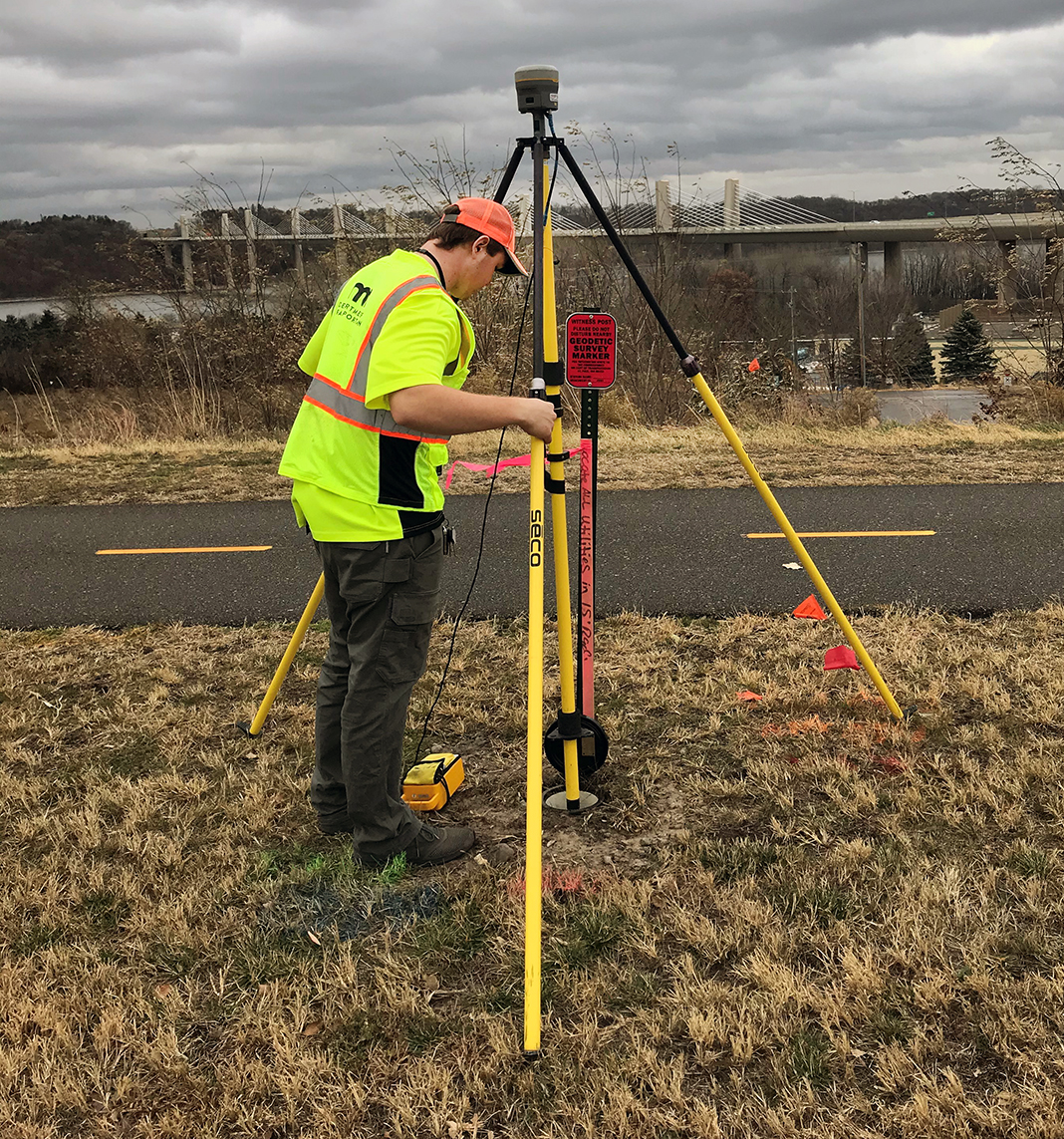By Joseph Palmersheim

Seth Langer, geodetic field surveyor, sets up his equipment for an observation. Photo by Mike Pemble |
Everything MnDOT does to build transportation infrastructure and acquire property starts with geodetic data: a coordinate system and a set of reference points used for locating places.
This data is shared with a variety of partners, including the National Oceanic and Atmospheric Administration.
MnDOT’s geodetic data-sharing partnership with NOAA recently garnered a shout-out on a national level: “Thanks to the herculean efforts at the Minnesota DOT over the past few years, they have accounted for nearly one third of all data submissions to date. Over 2,400 of the completed areas are in Minnesota alone!” according to a write-up in the October edition of NOAA’s Monthly GPSonBM Update.
The Monthly GPSonBM Update documents ongoing improvements made to the local accuracy of NOAA’s National Geodetic Survey’s national scale models. A variety of partners, including state DOTs like MnDOT, provide the data.
“The recognition from NGS validates the time and effort invested,” said Geoff Bitner, Land Management, who is also involved as a liaison with NGS. “This is months and months of work in the field coordinated by Mike Pemble, the geodetic field supervisor, and similar coordinating effort by Dave Streitz, supervisor, Land Management, to manage and prepare the data for submission to NGS. This project is just a cog in the wheel of a much bigger effort currently underway at NGS, so for them to take the time to acknowledge the team effort was really nice.”
The GPS on Bench Marks project aims to update existing benchmarks (points with known height values) and develop a new model without needing additional field work.
MnDOT’s role is to coordinate the field activities, collect the observations and submit the data to NGS. MnDOT also uses this data as the basis for all construction project designs and land acquisitions.
“MnDOT uses this data to connect our property acquisitions and assets to the local and national grids,” Bitner said. “That’s a pretty simple statement, but it’s actually incredible to consider. Imagine every light pole, sign base, bridge pier, catch basin, road edge, highway centerline, etc., is being positioned using various geospatial data collection instruments and can be related through a grid coordinate system that has its roots back to these physical monuments.”
There are a number of other field activities that MnDOT does related to geodetic observations, including:
- Mark reconnaissance – verifying that the mark (the monument indicating a survey point) still exists, updating the description, updating directions to find it, taking a quick GPS observation for position, and taking updated photos.
- Monumentation – set new marks that are needed in support of program delivery.
- Leveling – a traditional method for determining heights using digital leveling equipment.
All of this data is shared through MnDOT’s Geodetic Database, which compiles informational sheets for every station in the state. Both public and private surveyors can access this information.
While there is an electronic component to the work, it starts with someone being in the right place at the right time. Pemble organizes and schedules the GPS field activities. MnDOT has nine full-time employees and up to 11 additional student workers in the summer.
“Since we work all over the state, I need to plan accommodations and make sure all the equipment, from trucks to hammers, is in working order so that everyone can do their jobs,” he said. “Each employee operates up to four GPS receivers per day and is responsible for locating and observing each benchmark. This also includes taking two photos at each benchmark and filling out update-descriptive information and observation log sheets. Each night the crews submit their observation data and photos to me for review and preliminary processing for quality control. Then I post the data for the office to download and process prior to submittal to NGS.”
The monuments need to be durable and stable over time. These can range from a chiseled ‘X’ in a granite ledge, an iron rod driven in the ground, a metal stamped disk, or any number of other permanent objects that can be set in ground in such a way that they’ll remain for years. Some of these monuments are iron rods in the Red River Valley that are more than 100 feet long, driven into the soft soil.
In the end, these monuments, combined with the data, will form the bedrock for a new GPS model that could save the time and expense of having to remeasure in the field.
“The better the model, the less ‘rework’ we’ll need,” Bitner said. “For example, if I have old height values on drainage structures and a good transformational model, I can take those old heights from plans and mathematically transform them using the model and match them into new drainage structures without having to remeasure in the field. This one-time expense will pay dividends over and over in the years to come. By the developing the best model possible today, it ensures fewer errors in the future.”
NGS will build the 2022 Transformation Tool with data submitted by Dec. 31, 2021.
| 


